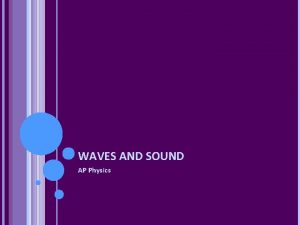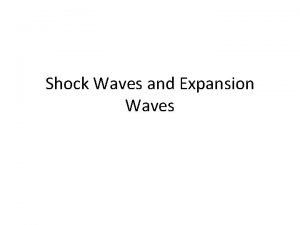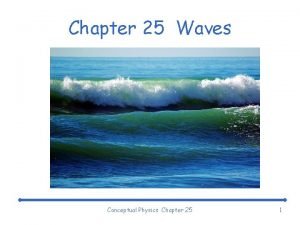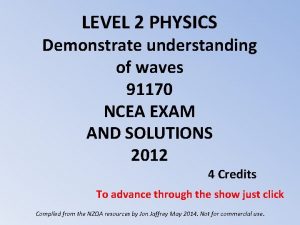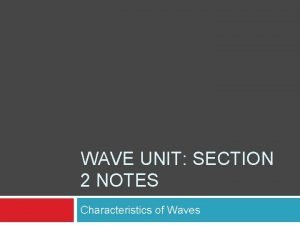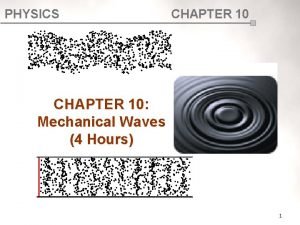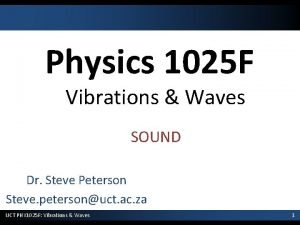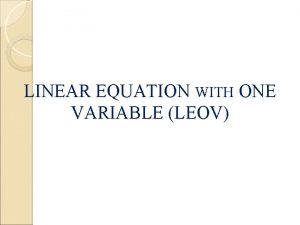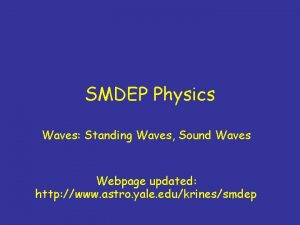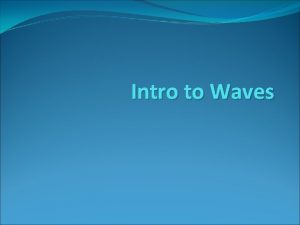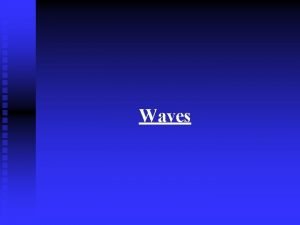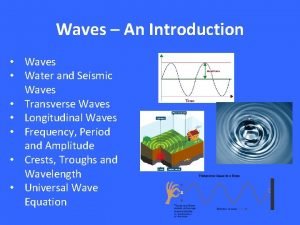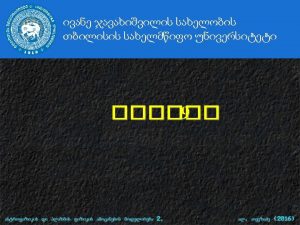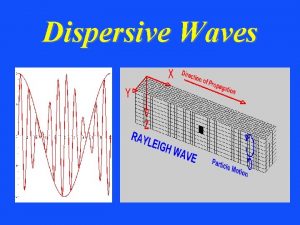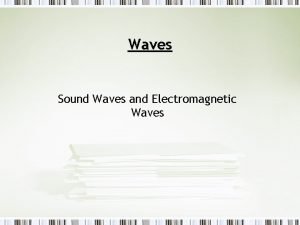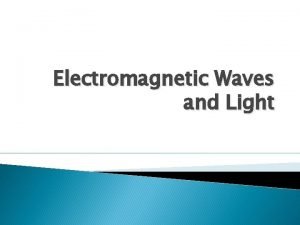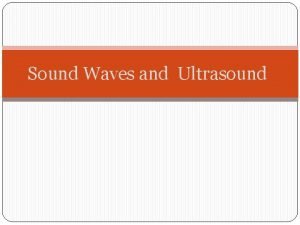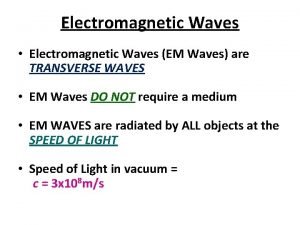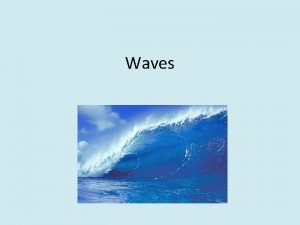Intro to Waves Physics Learning outcomes Learning Outcomes




































- Slides: 36

Intro to Waves Physics

Learning outcomes � Learning Outcomes � By the end of this topic you should be able to: � 1 Describe the rippling motion of a wave. � 2 State that waves carry energy. � 3 Compare longitudinal and transverse waves. � 4 Explain frequency as the number of waves per second. � 5 Measure the wavelength and amplitude of transverse waves. � 6 Use numerical or graphical information to determine the frequency of a wave. � 7 Use the equation speed = distance/time in wave calculations � 8 Use the equation speed = frequency x wavelength in wave calculations.

Big and small numbers

What are some examples of waves �Water waves �Sound waves �Radio waves �Mexican waves �Light waves �Microwaves �Any more? What do waves do? . . . . watch

Water Waves �Water waves are a rippling motion of the flat surface of water �Waves carry Energy!! Sometimes this can be quite dramatic……. . �big wave 2 �Typhoon lagoon �Mega tsunami

Amplitude (height) and Energy �Waves with a large amplitude (height) have more energy

Wave types: 1. Transverse wave Direction of wave In a transverse wave, the direction of the wave is at right angles to the movement of the object producing the wave. Examples of transverse waves are: water waves, light waves, Mexican waves

2. Longitudinal Wave In a longitudinal wave, the direction of the wave is in the same direction to the movement of the object producing the wave

Waves on a spring Transverse wave Longitudinal wave

Which type of wave? Transverse Water Light Mexican Radio Microwave Longitudinal Sound Note: A sound wave is the only type of wave that is longitudinal.

Wave Speed �Speed is a measure of how fast something is going. �It can be measured in: miles per hour (mph) kilometers per hour (km/h) metres per second (ms-1) In Physics: we usually measure speed in metres per second (ms-1) Speed is really a measure of the distance travelled in a specific time for example 60 km/h means that 60 km is travelled in a time of 1 hour. Bugati Veyron 300 mph peel car 35 mph

Measuring the Speed of Sound Watch this demonstration of how to measure the speed of sound using 2 microphones and an electronic timer

Reflection of Waves �Waves can reflect when they hit a surface. �An example of this as an echo: �Reflected sounds can be a nuisance in recording studios so the walls are lined with foam to absorb the sound energy. �The speed of sound can be measured by using reflected waves.

Measuring the Speed of Sound (2) • Measure distance to a large wall (50 m) • Set up clap echo rhythm so that you are clapping in sync with the echo that returns from the wall. • Measure the time for 20 clap echo’s • Divide the time by 20 to get the time for 1 clap echo

Speed of sound �Distance is measured in metres……. . �Time is measured in seconds……… �Speed is measured in metres per second (ms-1) Results: distance to wall and back = 100 m time for 20 claps = 6 s time for 1 clap = 0. 3 s Speed of sound = 100/0. 3 = 333 ms-1

Breaking the sound barrier �Aeroplanes can fly faster than sound. When they break the sound barrier there is a sonic boom clip

A simple wave What things could we measure about a wave? λ A A = Amplitude: the height measured from the middle to a crest in metres (m) λ = wavelength: the distance from one crest to the next crest in metres (m)

Wave characteristics symbol What it means Amplitude A Height measured from the middle to a crest (m) Wavelength λ Distance from crest to crest (m) frequency f Number of waves produced per second (Hz) velocity v speed of the travelling wave (m/s) period T Time for one wave to pass a point (s)

Frequency of a wave �Frequency is the number of waves produced in one second. �Frequency is measured in “hertz” (Hz) �Hertz means the same as “waves per second” so 440 Hz means 440 waves are produced per second We can see waves on a Cathode Ray Oscilloscope (CRO)

Period of a wave �The time taken for 1 complete wave (one crest until the next crest) to pass a point. Period in seconds (s) Frequency in hertz (Hz) Example: a wave has a frequency of 40 Hz. Calculate the period of the wave.

Frequency and wavelength �Low frequency waves �have a long wavelength �High frequency waves �Have a short wavelength

Sound waves �We can “see” the transverse electrical signal using a C. R. O. (Cathode Ray Oscilloscope) �The sound waves that come out of the speaker are longitudinal waves

Range of human hearing �Humans can hear a range of sounds : 20 Hz 20000 Hz

Wave calculations �To calculate speed we usually use �But for wave speed we have a special equation wave speed = frequency x wavelength v =f x λ

Wave calculations (1) (a) 0. 9 m (b) 5 m ( c) f =v/λ = 2. 5/5 = 0. 5 Hz

Wave Calculations 2 (i) λ= 40 m (ii) v =d/t =40/5 = 8 ms-1 (iii) f =v/λ = 8/40 0. 2 Hz

Sound Level �Loud sounds can damage your hearing. �Sound level is measured in decibels (d. B) �Sound of a rocket booster being tested here �Sound level is measured � with a decibel meter


Sound levels If the sound level is above 85 d. B for an extended period of time, then ear protectors should be worn. These absorb some of the sound energy and reduce the level reaching your ears.

Noise Cancellation Headphones

Ultrasound �Ultrasounds are sounds with a frequency above 20, 000 Hz. This is above the range of human hearing. Ultrasounds can be used in a number of useful ways: �Ultrasound scan of unborn baby �Mapping and finding things underwater (SONAR) �Car reverse parking systems. (Bats & dolphins find their way around using ultrasound!!)

Ultrasound Scan (watch) Ultrasound waves are transmitted into a pregnant woman’s abdomen. They are reflected back and an image is produced from the different reflections and displayed on a computer monitor.

Ultrasound example 1 A fishing boat 42 m above the seabed uses ultrasound to find fish. (speed of sound in water = 1500 ms-1) a) How long will a pulse of ultrasound take to travel to the seabed and back. b) What happens to the ultrasound signal if a shoal of fish swims 12 m under the boat? a) t=d/v = 84/1500 = 0. 056 s b) The pulse will return to the boat in a shorter time! (0. 016 s)

Ultrasound example 2 A pulse of ultrasound is reflected from a baby’s head. The pulse takes 9. 74 x 10 -5 s between being transmitted and received at the monitor. Calculate the distance to the baby’s head from the ultrasound monitor (4 marks) d =v x t = 1540 x 9. 74 x 10 -5 = 0. 15 m so distance to head is 7. 5 cm

Wave Diffraction �Diffraction is when waves bend around corners…. Long wavelength waves bend more than short waves. This is why you can hear the bass sounds from music better than the high frequencies from around the corner.

Wave diffraction �A ripple tank can be used to see water wave diffraction �Watch �Radio Wave diffraction �Watch 2
 Example of mechanical wave
Example of mechanical wave Sound waves are electromagnetic waves true or false
Sound waves are electromagnetic waves true or false Mechanical and electromagnetic waves
Mechanical and electromagnetic waves Difference between electromagnetic waves and sound waves
Difference between electromagnetic waves and sound waves Characteristics of a longitudinal wave
Characteristics of a longitudinal wave Is echolocation transverse or longitudinal
Is echolocation transverse or longitudinal Long waves and short waves
Long waves and short waves Difference between matter waves and electromagnetic waves
Difference between matter waves and electromagnetic waves Electromagnetic waves vs mechanical waves
Electromagnetic waves vs mechanical waves Similarities of mechanical and electromagnetic waves
Similarities of mechanical and electromagnetic waves Seismic waves
Seismic waves Seismic waves are mechanical waves
Seismic waves are mechanical waves Compare and contrast p waves and s waves using venn diagram
Compare and contrast p waves and s waves using venn diagram Mechanical and electromagnetic waves venn diagram
Mechanical and electromagnetic waves venn diagram Difference between constructive and destructive waves
Difference between constructive and destructive waves Ap physics waves
Ap physics waves Oblique shock angle
Oblique shock angle Physical science notes pdf download
Physical science notes pdf download Chapter 25 concept review conceptual physics waves
Chapter 25 concept review conceptual physics waves Nzqa level 2 waves
Nzqa level 2 waves Transverse wave
Transverse wave Displacement equation
Displacement equation Waves physics
Waves physics Andrew ng intro machine learning
Andrew ng intro machine learning Introduction to machine learning andrew ng
Introduction to machine learning andrew ng Expected outcome example
Expected outcome example Water cycle learning outcomes
Water cycle learning outcomes Objectives of notice writing
Objectives of notice writing Swot analysis objectives
Swot analysis objectives Objectives of teaching rhymes
Objectives of teaching rhymes Example of learning objectives
Example of learning objectives What is photolysis in photosynthesis
What is photolysis in photosynthesis Photosynthesis learning objectives
Photosynthesis learning objectives What is ncbts
What is ncbts Learning objectives of linear equations in one variable
Learning objectives of linear equations in one variable A machine that converts mechanical energy into electricity
A machine that converts mechanical energy into electricity Learning outcomes for direct and indirect speech
Learning outcomes for direct and indirect speech















